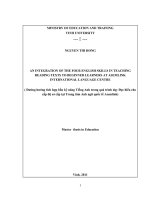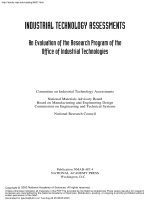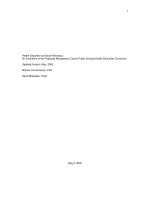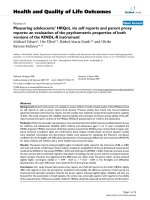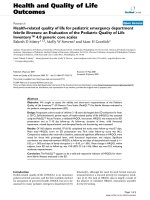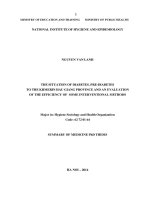An evaluation of the textbook “english id 1” used at tri duc high school
Bạn đang xem bản rút gọn của tài liệu. Xem và tải ngay bản đầy đủ của tài liệu tại đây (1.95 MB, 142 trang )
MINISTRY OF EDUCATION AND TRAINING
HO CHI MINH CITY UNIVERSITY OF TECHNOLOGY
---------------------------
AN EVALUATION OF THE TEXTBOOK
“ENGLISH ID 1” USED AT TRI DUC HIGH SCHOOL
Submitted to the
Faculty of English Language
in partial fulfillment of the Master’s degree in English Language
Course code: 1641900017
By
PHAM VAN MANH
Supervised by
Dr. LE VAN TUYEN
HO CHI MINH CITY, March/2018
MINISTRY OF EDUCATION AND TRAINING
HO CHI MINH CITY UNIVERSITY OF TECHNOLOGY
---------------------------
AN EVALUATION OF THE TEXTBOOK
“ENGLISH ID 1” USED AT TRI DUC HIGH SCHOOL
Submitted to the
Faculty of English Language
in partial fulfillment of the Master’s degree in English Language
Course code: 1641900017
By
PHAM VAN MANH
Supervised by
Dr. LE VAN TUYEN
HO CHI MINH CITY, March/2018
CERTIFICATION OF THESIS DEFENSE
THE THESIS WAS WRITTEN AT
HOCHIMINH CITY UNIVERSITY OF TECHNOLOGY
Academic supervisor name : Dr. LE VAN TUYEN
The thesis defense session was conducted at Hochiminh City University
of Technology (HUTECH) on April, 6th 2018.
The Board of Examiners for the Master’s Thesis Defense
NAME
FUNCTION
TT
1
Dr. NGUYEN THI KIEU THU
Chair
2
Dr. LE THI THANH
Reader 1
3
Dr. TRAN QUOC THAO
Reader 2
4
Dr. PHAM NGUYEN HUY HOANG
Member
5
Dr. NGUYEN DANG NGUYEN
Secretary Member
On behalf of the Board of Examiners
Chair
HCMC, April 6th 2018
HCMC UNIVERSITY OF TECHNOLOGY
POSTGRADUATE INSTITUTE
MASTER’S THESIS TASK REPORT
Student name: PHAM VAN MANH
Sex : Male
Date of birth: 18/05/1990
Place of birth : NINH BINH
Major: English Language
Student code: 1641900017
I- Thesis title:
AN EVALUATION OF THE TEXTBOOK “ENGLISH ID
1”
USED AT TRI DUC HIGH SCHOOL
II- Task description and contents:
- Students' and teachers’ attitudes and perceptions towards the textbook English ID 1
- The extent the teachers use and exploit the textbook in the classroom.
Through the investigation, strengths and weaknesses of the textbook itself as well as of
the way it is exploited are elucidated and recommendations are made for both designers
and teachers.
III- Starting date: 01/08/2017
IV- Completing date : 17/03/2018
V- Academic supervisor: Dr. LE VAN TUYEN
SUPERVISOR
LE VAN TUYEN
FACULTY DEAN
i
CERTIFICATE OF ORIGINALITY
I certify my authorship of the Master’s thesis submitted today entitled:
AN EVALUATION OF THE TEXTBOOK
“ENGLISH ID 1” USED AT TRI DUC HIGH SCHOOL
In terms of the statement of requirements for Theses in Master’s programs issued by
the Higher Degree Committee of Faculty of English Language, Ho Chi Minh City
University of Technology.
Ho Chi Minh City, March/ 2018
PHAM VAN MANH
ii
RETENTION AND USE OF THE THESIS
I hereby state that I, PHAM VAN MANH, being a candidate for the degree of
Master of Arts (English Language) accept the requirements of the University
relating to the retention and use of Master’s Theses deposited in the Library.
In terms of these conditions, I agree that the original of my Master’s Thesis
deposited in the Library should be accessible for purposes of study and research, in
accordance with the normal conditions established by the Librarian for the care,
loan, and reproduction for theses.
Ho Chi Minh City, March 2018
Signature …………………………….
PHAM VAN MANH
iii
ACKNOWLEDGEMENTS
This research would have never been completed without the assistance of
some people who always gave support and useful recommendations. I would like
to express my deep gratitude and heartfelt thanks to a number of people. Without
them, this research study would not have succeeded.
First of all, I would like to express my gratitude to Dr. Le Van Tuyen, my
advisor, for his helpful suggestions, guidance and time which inspired me to do my
best to complete this study. He gave me not only invaluable, constructive and
insightful suggestions tirelessly, but also warm encouragement.
Next, I am also really grateful to all lecturers for their helpful instruction
during the Master of Art course as well as the staff of Graduate Studies at Ho Chi
Minh City University of Technology for their kind assistance.
My honest thanks go to Ms. Nguyen Thi Phung, Vice-principal of Tri Duc
High School for her support and all the colleagues who are the English teachers at
Tri Duc High School, as well as students at Tri Duc High School, for their
contribution, enthusiastic engagement in the survey for questionnaires and
interviews.
I would like to thank my classmates who provided me a number of sincere
advices and shared with me a lot of knowledge and learning experience during the
course. Without their help, I think I could have never been completed the courses.
Finally, I would like to express my deepest gratitude to my family for their
spiritual as well as material supports, especially, my wife who has always supported
and encouraged me to overcome all the difficulties in completing this study.
iv
ABSTRACT
Textbooks play a key component in most language teaching programs. A
textbook seems to become the main tool for teachers to convey language knowledge
to English as a foreign language (EFL) learner. The present study aims to
investigate students' and teachers’ attitudes and perceptions towards the textbook
“English ID 1” which used at Tri Duc High School (TDHS) at the pre-intermediate
level and the extent the teachers use and exploit the textbook in the
classroom. Through the investigation, strengths and weaknesses of the textbook
itself as well as of the way it is exploited are elucidated and recommendations are
made for both designers and teachers. 308 students and 18 teachers comprising
males and females participated in this study. The instruments employed in the study
were a textbook evaluation questionnaire adapted and modified from some variety
checklists of many researchers, semi-structured interviews with ten students and
five teachers and classroom observations. The 42-item questionnaire using 5-point
Likert scale rating from “1=Strongly Disagree” to “5=Strongly Agree” was
employed to elicit participants’ response to six main categories including Overall
Assessment, Practical Consideration, Language Skills, Subject and Content,
Organization and culture. Descriptive statistics were carried out to interpret the
quantitative data by utilizing mean and standard deviation. The data analyzed from
the interviews, classroom observation and the syllabus and textbook were analysed
based on “Content Analysis”. The results showed that both teachers and students
had active perceptions regarding the strengths and weaknesses of the textbook and
they thought that it was consistent with English teaching and learning process at
their school. In addition, it also revealed that the teachers had some problems in the
use of textbook English ID 1 in the classroom
v
TABLE OF CONTENTS
PAGE
CERTIFICATE OF ORIGINALITY ........................................................................... i
RETENTION AND USE OF THE THESIS...............................................................ii
ACKNOWLEDGEMENTS ...................................................................................... iii
ABSTRACT ............................................................................................................ iv
TABLE OF CONTENTS .......................................................................................... v
LIST OF TABLES ................................................................................... viii
LIST OF ABBREVIATIONS .................................................................................... ix
CHAPTER 1 INTRODUCTION ............................................................................... 1
1.1 Background to the study ........................................................................ 1
1.2 Problem statement.................................................................................. 5
1.3 Thesis statement ..................................................................................... 6
1.4 Purpose of the study ............................................................................... 6
1.5 Scope of the study .................................................................................. 7
1.6 Significance of the study........................................................................ 7
1.7 Organization of the thesis ...................................................................... 7
CHAPTER 2 LITERATURE REVIEW .................................................................... 9
2.1 Introduction ............................................................................................ 9
2.2 Theoretical Foundation .......................................................................... 9
2.2.1 Materials and Textbooks .............................................................................9
2.2.1.4 Advantages and Disadvantages of the textbook and its roles in the classroom
........................................................................................................... 14
2.2.2 Textbooks Evaluation ................................................................................19
2.3 Some review of previous studies ......................................................... 30
2.3.1 Studies on textbook evaluation in Vietnam...............................................31
2.3.2 Studies on textbook evaluation at overseas ...............................................33
2.4 Summary .............................................................................................. 39
CHAPTER 3 METHODOLOGY ............................................................................ 40
vi
3.1 Introduction .......................................................................................... 40
3.2 Research site ........................................................................................ 40
3.3 Participants of the study....................................................................... 41
3.3.1 Students .....................................................................................................41
3.3.2 Teachers .....................................................................................................43
3.4 Description of the textbook.................................................................. 44
3.5 Research Method ................................................................................. 47
3.6 Research instruments ........................................................................... 49
3.6.1 Questionnaire .............................................................................................49
3.6.2 Interviews ..................................................................................................53
3.6.3 Classroom Observation .............................................................................54
3.7 Data Collection .................................................................................... 55
3.7.1 Procedure of conducting questionaires ............................................. 56
3.7.2 Procedure of conducting interviews ................................................. 57
3.7.3 Procedure of conducting classroom observation .............................. 58
3.8 Data analyses ....................................................................................... 58
3.9 Summary .............................................................................................. 60
4.1 Introduction .......................................................................................... 61
4.2 The Results of the study....................................................................... 61
4.2.1 Research Question 1: Students and Teachers’ perceptions towards
the textbook “English ID 1” ...................................................................................... 61
4.2.2 Research question 2: The extent teachers use and exploit the textbook in
the classroom ......................................................................................................76
CHAPTER 5 CONCLUSION ................................................................... 87
5.1 Summary of the results ........................................................................ 87
5.1.1 Students and teachers’ perceptions towards the textbook English ID 1 ...87
5.1.2 The extent the teachers used the textbook in the classroom .....................89
5.2 Implications of the research ................................................................. 89
5.3 Limitation ............................................................................................. 90
vii
5.4 Recommendations ................................................................................ 90
5.4.1 For the curriculum managers .....................................................................90
5.4.3 For EFL Teachers ......................................................................................91
5.4.1For the students .................................................................................. 92
5.4.4 Recommendations for further research ............................................. 92
REFERENCES .......................................................................................................... 93
APPENDIXES
viii
LIST OF TABLES
Table 3.1: Demographic Profile of Students. ........................................................ 41
Table 3.2: Demographic Profile of Teachers. ....................................................... 43
Table 3.3: Language Map of Unit 1 ....................................................................... 46
Table 3.4: Reliability analysis of scales ................................................................. 52
Table 3.5: Coding for Classroom Observations ................................................... 55
Table 4.1 Descriptive Statistics for the Overall Assessments .............................. 62
Table 4.2 Descriptive Statistics for the Practical Consideration ........................ 64
Table 4.3 Descriptive Statistics for the Language Skills ..................................... 66
Table 4.4 Descriptive Statistics for Subject and Content .................................... 71
Table 4.5 Descriptive Statistics for the Organization .......................................... 73
Table 4.6: Descriptive Statistics for the Culture .................................................. 74
Table 4.7: Number of Units and Time distribution for each semester .............. 77
Table 4.8: Content Division and Time Allocation ................................................ 79
ix
LIST OF ABBREVIATIONS
EFL:
English as a Foreign Language
ELT:
English Language Teaching
MOET:
Ministry of Education and Training
ESL:
English as a Second Language
TDHS:
Tri Duc High School
1
CHAPTER 1
INTRODUCTION
1.1Background to the study
There is no doubt that English has been the international language all over
the world and it is playing an important role in international relationships. For some
countries, English language education has become a major attention of their policy
makers. However, educational policy of these governments has influenced their
communities in different ways that are often controversial (Khajavi & Abbasian,
2011). Chang (2006) asserts that English has been the popular foreign language in
the curriculum of educational institutions and in foreign language learning and
teaching contexts. There is no doubt that many countries are attempting to support
English education in order to engage actively in international activities. Therefore,
the finding the ways which help in teaching English and culture in a balanced
manner seems unavoidable.
The textbook is an important element as well as the main source of input of
EFL curriculum in non-English speaking contexts. It also provides the content of
the curriculum regarding language knowledge, skills, and culture. It not only
supports teachers in their instruction and teaching but also helps both teachers and
students accomplish their own teaching and learning objectives. Besides, the
textbooks also influence teachers seriously, because they provide patterns and
guidelines to teachers so that they could teach in a better way and help the students
for better learning. Although recent technological innovations have helped much for
education to teach in new ways and to reach new goals, the published textbooks are
still the most commonly used source material for most instructional situations.
Hence, many new commercial textbooks are regularly published to serve for the
changing focuses of instruction and the changing language learners’ needs in
language learning and teaching process. That is the reason why it is important to
2
decide on which language textbooks are most useful for both students and teachers
in the particular situation.
Nowadays, a number of English teaching materials on the market have been
growing increasingly, making the choice of a good textbook seem to be a
challenging task. Tomlinson (2003) states that the research about materials
development did not have enough attention until the 1990s when textbooks on this
subject started to be published and materials or textbooks evaluation has become a
new trend in the process of language learning and teaching. Textbook evaluation is
the significant importance because it leads to a much better understanding of the
nature of particular learning and teaching contexts. Furthermore, the analysis and
evaluation of what is happening in the learning and teaching situation are going to
provide the teachers with more accurate information about the nature of the
exploited textbooks. The textbook evaluation of some teachers is more important
than designing courses because their schools usually force them to teach from a
textbook which was designed for their own teaching purposes. When a textbook has
been selected and purchased, then there is the responsibility to exploit it even if it is
not highly suitable for a particular purpose or situation. Thus, it is worth spending
much time considering the quality of the textbook in a systematic way. Textbooks
are an essential element in learning and teaching process because they partly
describe what is taught, what is ordered as well as what learners study. Therefore,
producing a well-designed and marketable textbook and selecting an appropriate
textbook and using it effectively are of vital importance and difficult challenges.
Vietnamese people have learned English for a long time and teaching EFL has
been becoming more and more popular. All of the public or private schools in
Vietnam offer compulsory English courses. French, Chinese, Japanese and so on are
also taught at most schools, but English has obtained a privileged status in the
education system in the past decades. In Vietnamese high schools, textbooks are a
compulsory part of English teaching and learning. For public and private high
schools, they both have used the standard textbooks published by Ministry of
3
Education and Training (MOET). However, in addition to the use of those
textbooks, they usually select more suitable textbooks for their own students to help
them more and more developing in English language learning. With the numerous
numbers of textbooks today, the decision to choose a textbook cannot be taken
lightly and it is whether acceptable or not is a difficult question. In Vietnamese
education, English language is now a compulsory subject in the curriculum for
general education from grades 6 to 12 and optional one for primary school
education from grades 3 to 5. It means that the presence of a textbook is necessary
to support the learning and teaching process. In fact, there have been many
textbooks published to fulfill the need of English textbook but there are not any
completely perfect textbooks or set of materials. Therefore, it is the important task
of the English teachers and researchers to choose a textbook that is appropriate for
learners. Cunningsworth (1995) said there were not any coursebook designed for a
general market meet the learners’ needs ideally. Thus, when the selection of a new
textbook is important in conducting an evaluation to ensure that it is suitable and
certain criteria must be considered in the evaluation process. Hence, every school
has different objectives and students have different backgrounds, abilities and needs
so the criteria of textbooks will vary. Tomlinson (1996) also suggests that material
evaluation process can be seen as the way to develop our language understanding
which will contribute to both acquisition theory and pedagogic practices
The selection of the textbook will base on the curriculum’s overall
orientation of every school but it is important to focus on approaches and
syllabuses, which are understood as ways of defining what the students really need
to learn and syllabuses cover all instructional objectives, techniques, and exercises,
language items as well as the four skills (Brown, 1995). Moreover, Cunningsworth
(1995) mentions that all of the textbooks reflect the purposes, methods and values
of the curriculum, so it is very important that the textbook must be selected
carefully. Its aim should be found out in order to meet the needs and interests of the
students to the highest level. Additionally, when selecting a textbook, policy-
4
makers, managers or teachers should look over some elements such as context,
beliefs about how people learn languages, students’ needs and interests, and student
diversity (Graves, 2000; Butcher et al., 2006). Furthermore, the textbooks should be
consistent with the studying level, have the expectations on students clearly, help
students engage their learning to their own knowledge or experience, provide
opportunity for students to review in their learning and allow students to attend in
meaningful interaction with one another for communicative purposes (Wajnryb,
1995; Cunningsworth, 1995)
Habtoor (2012) states that some textbooks are published annually in the world
and a number of them are designed mainly for ESL and EFL situations. This result
is very different from among teachers, especially the teachers having little or no
teaching experience in language teaching; even experienced teachers also might
find it a challenging task to select a textbook for their own groups. Therefore,
selection and textbook evaluation are important and considered to be an essential
problem for teachers and curriculum developers in language teaching contexts. This
is the major reason why they have to tend to evaluate textbooks carefully. In fact,
there are many reasons for evaluating textbooks. Sheldon (1988) believes that
textbooks should be evaluated for two main reasons. First, it will help the teacher or
curriculum managers in making decisions on selecting the appropriate textbook.
Second, it would consider the pros and cons of a textbook which familiarizes the
teacher with its probable strengths and weaknesses. Moreover, another reason as
Cunningsworth (1995) highlighted is to identify particular strengths and weaknesses
in textbooks already in use. As a result, weak points will be improved through the
using and adapting the supplementary materials from other textbooks. Besides, he
also emphasizes that textbook evaluation can also be a valuable constituent of
teacher training programs with the purpose of making teachers have awareness of
important features in looking for in textbooks when they familiarize with plenty of
published language instruction textbooks. Ellis (1997) also says that textbook
evaluation would help teachers much in their skills development as well as
5
professional growth. Moreover, he maintains that textbook evaluation helps teachers
move beyond impressionistic assessments and it helps them to acquire useful,
accurate, systematic, and contextual insights into the overall nature of the textbook
and material. Therefore, Litz (2005) concludes that textbook evaluation can seem as
a particularly meaningful mean of conducting action research as well as a form of
professional empowerment and improvement.
1.2 Problem statement
Nowadays, English education starts in kindergarten and continues to
university in Vietnam. From kindergarten to secondary school the students learn
reading, writing, listening and the basic grammatical rules of speaking. They learn
more advanced English at the high school, including more sophisticated grammar,
pronunciation, vocabulary and other skills. Therefore, all high schools usually
choose to learn with more other materials to help their students get the knowledge
better and better. This leads to the appearance of the more published textbooks
which have not been evaluated about content and quality carefully yet to meet these
needs.
In English language teaching context in Vietnam, the field of textbook
evaluation so far has some limitations while the publishing of ELT materials is
growing dramatically. Firstly, At TDHS, the policy-makers have been using English
ID series for the courses “English for Communication” and they hope to help
students improve their English skills. However, till now, there are not any
evaluation conducted to examine the strong and weak points of English ID series or
to acquire teachers and learners’ perspectives and attitudes toward the textbooks
since they are published and applied into some Vietnamese high schools and some
foreign language centers. Secondly, as an English teacher at TDHS for 2 years, the
researcher recognized that there are many existing problems in using the English ID
series from teachers’ and students’ perceptions. Some students also stated that
although they could reach the positive results of the course, they still could not
apply linguistic knowledge and skills studied in real life, as well as communicating
6
on the daily activities. Thus, it is necessary to get teachers and students to raise their
voice about these issues. In order to fill the gap in this field, the researcher
conducted this study to explore teachers’ and students’ attitudes and perceptions
towards the English ID textbook as well as examining how the appropriateness of
the textbook meet the needs of students. The researcher expected that through this
study will provide valuable insights for English language curriculum designers,
teachers and students in the context and will make a small contribution to enhancing
the teaching and learning of English in Ho Chi Minh as well as in Vietnam.
1.3 Thesis statement
This study evaluates the textbook “English ID 1”, an English textbook from a
series of four textbooks of Paul Seligson (Series Author); Tom Abraham; Cris
Gontow; Carol Lethaby published by Richmond publisher in 2013. This textbook is
used for all students from grades 6 to 12 (ages 12 to 18) at the pre-intermediate
level at TDHS of Vietnam since 2015. The textbook was included students’ book,
workbook, and teachers’ manual. Students have learned this textbook with
Englishcentral.com website is at the core of the teaching and learning process in the
classroom. This study attempts to find answers to the following research questions:
1. What are students and teachers’ perspectives towards the elements of textbook “
English ID 1” in term of Overall Assessments, Practical Considerations,
Language Skills, Subject and Content, Organization and Culture?
2. How do teachers use and exploit the textbook in the classrooms?
1.4 Purpose of the study
The overall purpose of the study is to evaluate the whole textbook regarding
Overall Assessments, Practical Considerations, Language Skills, Subject and
Content, Organization and Culture, which will elucidate the strengths and
weaknesses of the textbook used in the teaching and learning context at TDHS.
More specifically, first, the study aims to investigate students and teachers’ attitudes
towards the textbook English ID 1 designed for high school young learners. Second,
7
the researcher wants to discover the extent the teachers use and exploit the textbook
in the classroom which will help English teaching and learning at TDHS and some
language centers become more interesting and effective in the future.
1.5 Scope of the study
This study focuses on the textbook English ID 1 used in English teaching and
learning at the TDHS in Tan Phu District of Ho Chi Minh city. Thus, these results
cannot apply to all districts in the Ho Chi Minh City as well as all other high
schools in Vietnam. In fact, there are four textbooks in this English ID series but the
researcher chooses only English ID 1 to evaluate. Moreover, this study bases on the
criteria of good textbooks and focuses on the appropriateness of the analyzed
textbooks. Furthermore, the textbook is intended for high school students who are
considered young learners of the level of pre-intermediate. As a result, some
suggestions made and implications drawn in the study cannot easily be generalized
to textbooks for other English learners at different schools
1.6 Significance of the study
The results of the study may help the administrators, teachers, students have
an overview of the strengths and weaknesses of the textbooks in order to adapt the
textbooks more effectively in their educational setting and to meet the objectives of
the course. Consequently, the results might be beneficial for all users including
teachers and students and useful for the curriculum developers, policymakers or
publishers in selecting or developing a textbook. Moreover, the results would be the
useful recommendations for teaching and learning English at TDHS to become
more successfully and effectively. It is fully hoped that the recommendations
emanated from this study will be one of the ideas to be considered when the MOET
of Vietnam embrace changes in the EFL curriculum.
1.7 Organization of the thesis
The researcher is going to organize this study in order to get the reader easier
to understand. The following part shows the content of five chapters covered in this
8
study. The first chapter introduces the context and background of the study, the
purposes, research questions, and the scope as well as the significance of the study.
Chapter two contains the literature review, with a discussion of textbooks, the
textbook design, and the role of the textbook in the ELT classroom, the use of
textbook and textbook evaluation used in this research. This chapter also has
reviewed some previous studies on textbook evaluation in the recent years. Chapter
three is the research design and methodology chapter. It restates the research
questions and discusses some issues about mixed methods in textbook evaluation.
Moreover, data collection instruments and data analysis are presented in this
chapter. Chapter four is the research results and discussions one which proposes the
result of the study. In this chapter, the researcher is presenting the discussion and
findings, which consist of the data analysis. In chapter five, the researcher
summarizes the results based on the results of the previous chapter, along with the
implication and some recommendation for further research.
9
CHAPTER 2
LITERATURE REVIEW
2.1 Introduction
This study may have additional implications related to the possible stages
occurring in the design of language curriculum programs in high schools in
Vietnam. Post-evaluation of English teachers and students regarding the ELT
textbook used at TDHS can be considered as another implication of the study. This
chapter reviews four major parts relevant literature review. First are materials and
textbooks in language learning and teaching with the definition of them, textbook
design, the advantages and disadvantages of textbooks, the roles, use and
exploitation of textbook in English language classroom. The second part discusses
textbook evaluation which contains the definition of textbook evaluation, the reason
for evaluating the textbook, the methods of textbook evaluation and criteria for
textbook evaluation to help the reader more comprehension about the textbook
evaluation process. In third one, the researcher is going to give the theoretical
framework for textbook evaluation in the classroom. The fourth one will describe
some previous textbook evaluation studies consist of both studies in Vietnam and at
overseas.
2.2 Theoretical Foundation
2.2.1 Materials and Textbooks
2.2.1.1 Materials
Some people estimated that a textbook carries a bit more weight in the
consideration of the material. However, according to Tomlinson (2001) states the
materials consist of anything which can be used to facilitate the teaching and
learning languages. In the other words, materials also are the form of a textbook, a
workbook, a CD-Rom, a video, a photocopied handout, a cassette, a newspaper, a
paragraph written on a whiteboard or anything that presents or informs related to the
language knowledge being learned. These kinds of materials can be exploited easily
10
and effectively for language learning and teaching process. The term textbooks and
coursebooks often interchangeably used in English language teaching process.
Therefore, in this master thesis the terms ‘textbook,’ ‘coursebook,’ and ‘material’
are usually used interchangeably.
Hutchinson and Gault (2008) believe that EFL textbooks are to provide
learners with necessary knowledge, language skills and information about English
speaking countries and preparing for communication with people from foreign
countries and different cultural backgrounds. Textbooks usually combine
contemporary and traditional approaches to language teaching in order to develop
skills to learners, to instruct and help them understand about whole the courses,
which provides a grammar framework and a thorough practice of vocabulary,
grammatical structures and functions. Lappalainen (2011) states that a textbook
includes all books published for educational purpose or even any books used as a
tool in the classroom. He also asserts that an EFL textbook is also defined as a guide
forming the image of the English language and culture and the practice studying
English. Hutchinson and Torres (1994) claim that learning and teaching situation is
not going to complete without using the relevant textbook. McGrath (2002) believes
that the EFL textbook is useful since it establishes the direction, content, and
cultural to a certain degree how the lesson is to be taught. He also declares that
teachers’ images reflect their attitudes and beliefs toward textbooks which will
influence the textbook used by them.
2.2.1.2 Textbooks
According to Oxford Advanced Learner’s Dictionary, a textbook is defined as
“a book that teaches a particular subject and that is used especially in schools and
colleges” (OALD, 2000, p.1238). In the other word, a textbook is a material that
contains data about a subject which learners study especially at school or college
(Longman Dictionary, 2003). Furthermore, Awasthi (2006) gives the definition that
a textbook is a teaching and learning material for both the teachers and the students
11
to help them in the process of learning and teaching and Tomlinson (2011) also
defines the textbook as one of the materials used to help teachers and learners.
Hutchinson and Torres (1994) say that a textbook is as an instruction for teachers in
teaching approach, and as a tool for learners to revise knowledge. Besides, it is also
believed a record for measuring what has been taught by the teachers. Tomlinson
and Masuhara (2010) mention that a number of issues which need to be considered
carefully before starting to write a textbook such as needs analysis, language
learning principles, the target of students and teachers. These are the important
matters which are looked over in this study to find out suitable textbooks for
different situations. Besides, they also have much benefit for both teachers and
students in learning and teaching process. Additionally, textbooks are as a principle
which serves as a guide to be used in a systematic way in the classroom as a basis of
language course (Ur, 1996). Furthermore, they are also specifically designed for the
specific target to learners in particular context. Additionally, the traditional textbook
often has a number of chapters with differences long texts that deal with various
topics (Cecilia, 2006). Moreover, there is a different theme for each chapter and
sometimes there are some pre-reading activities or post-reading exercises and they
can often be listened to on CD or tape. In many cases, the textbook and the
workbook are sometime joined together in the same book, but sometimes they are
represented by two separate books. In fact, a textbook is always accompanied by
other materials such as CDs, cassettes, tests and a teacher’s guide.
2.2.1.3 Textbook Design
Prowse (1998, 2011) reports that inspiration comes writers’ hands cannot
follow the speed of their thoughts. However, when they do not have ideas, it is
frustrating (Tomlinson, 2003). “Many of the materials developers describe materials
writing processes which are ad hoc and spontaneous and which rely on an intuitive
feel for activities which are likely to work”(Tomlinson, 2003, p.107). In spite of
admitting that writing is free and spontaneous, Tomlinson and Masuhara (2010)
mention a number of issues which need to be considered carefully before preparing
12
to write any textbooks such as needs analysis, language learning principles,
purposes of students and teachers. Materials researchers have provided checklists to
instruct how to write language textbooks. These can be divided into two main
categories. Firstly, they indicate the steps that people should do when they are ready
to write materials and textbooks. Secondly, they focus on the specific principles for
writing the content of textbooks.
The material writing stage that suggested by Jolly and Bolitho (2011, cited in
Nguyen, 2015) includes seven steps as follows
Identification of need for materials
Exploration of need
Contextual realisation of materials
Pedagogical realisation of materials
Production of materials
Student use of materials
Evaluation of materials against agreed objectives
It is important for the textbook to be used exactly in the particular context
and situations. The instructions, exercises and activities are vague, which are going
to reduce the comprehension, participation and confidence of the learners in
classroom activities. Moreover, according to Dat (2008) states textbooks should
include common topics, such as social issues, economic achievements;
environment, sports etc and they should not consist of controversial issues related to
religion, superstition, etc. Although people sometimes want to learn about other
cultures, it is difficult for them to apply this to their daily communication or the
description of their surroundings. It is more difficult for children who do not have
enough background knowledge to understand the issues and apply them. The
appearance of the textbooks is also one of the elements that textbook writers have to
consider before publishing a textbook, because it makes an important first
impression for users before they consider other ones.

